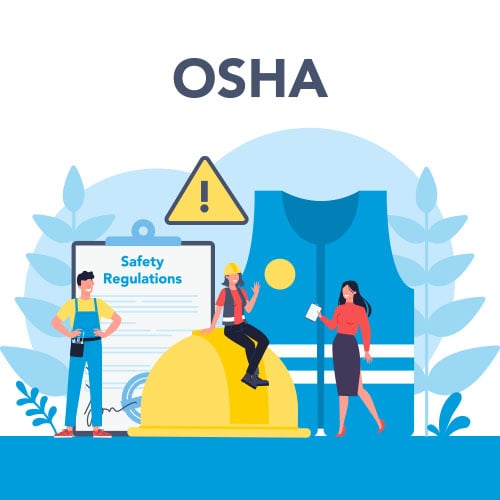
Knowing what key safety acronyms stand for allows you to assess risks and respond to emergencies. Whether you’re starting a warehouse or training your warehouse staff, use our safety acronyms guide to educate yourself on the most common safety terms.
Safety Abbreviation
Safety acronyms exist to make communication easier, but the sheer volume of safety abbreviations can undermine this goal. For ease of comprehension, we’ve broken safety abbreviations into four categories: safety organization acronyms, legal safety acronyms, safety standards acronyms, and safety terms acronyms.
Safety Organization Acronyms

Numerous safety organizations exist to foster positive health and environmental outcomes. Most safety organizations have long and complex names that are tiresome to read and speak. To make safety paperwork scannable and conversation succinct, many safety organizations have abbreviated titles. Discover the most common safety organization acronyms below.
- ACGIH - American Conference of Governmental Industrial Hygienists
- ADA - Americans with Disabilities Act
- AGA - American Gas Association
- AIHA - American Industrial Hygiene Association
- ANSI - American National Standards Institute
- APHA - American Public Health Association
- ASAE - American Society of Agricultural Engineers
- ASHRAE - American Society of Heating, Refrigeration and Air Conditioning Engineers
- ASP - Associate Safety Professional
- ASQC - American Society for Quality Control
- ASSE - American Society of Safety Engineers
- ASTM - American Society for Testing Materials
- BCSP - Board of Certified Safety Professionals
- BSI - British Standards Institute
- CSA - Canadian Standards Association
- CAL-OSHA - California Occupational Safety and Health Administration
- CGA - Compressed Gas Association
- CIH - Certified Industrial Hygienist
- CSFM - California State Fire Marshal
- CSP - Certified Safety Professional
- DOE - Department of Energy
- DOL - Department of Labor
- DOT - Department of Transportation
- EEOC - Equal Employment Opportunity Commission
- EPA - Environmental Protection Agency
- FDA - Food and Drug Administration
- FM - Factory Mutual
- GSA - General Service Administration
- IARC - International Agency for Research on Cancer
- IATA - International Air Transportation Association
- ICAO - International Civil Aviation Organization
- IEC - International Electrotechnical Commission
- IMO - International Maritime Organization
- ISEA - Industrial Safety Equipment Association
- ISO - International Organization for Standardization
- MSHA - Mine Safety and Health Administration
- NEMA - National Electrical Manufacturers Association
- NFPA - National Fire Protection Association
- NIOSH - National Institute of Occupational Safety and Health
- NIST - National Institute of Standards and Technology
- NMFC - National Motor Freight Class
- NRC - Nuclear Regulatory Commission
- NSC - National Safety Council
- NSF - National Sanitation Federation
- NTP - National Toxicology Program; Normal Temperature and Pressure
- OSHA - Occupational Safety and Health Administration
- SAE - Society of Automotive Engineers
- UL - Underwriters Laboratories
- ULC - Underwriters Laboratories of Canada
- UN - United Nations
- USCG - United States Coast Guard
- USDA - United States Department of Agriculture
- USFDA - United States Food and Drug Administration
- USP - United States Pharmacopoeia
Legal Safety Acronyms

Safety legislation affects commercial businesses. Many governmental safety acts have long names abbreviated for convenience. Use our list below to understand what legal safety acronyms are referring to so you can abide by safety laws in your workplace.
- CAA - Clean Air Act
- CERCLA - Comprehensive Environment Response, Compensation and Liability Act
- CFR - Code of Federal Regulations
- CWA - Clean Water Act
- EN - European Norms
- FIFRA - Federal Insecticide, Fungicide and Rodenticide Act
- FMCSR -Text Federal Motor Carrier Safety Regulations
- HCA - Hazardous Communication Act
- HMTA - HMTA
- IP - Industrial Plus
- MUTCD - Manual for Uniform Traffic Control Devices
- NEC - National Electric Code
- NEPA - National Environmental Policy Act
- RCRA - Resource Conservation and Recovery Act
- REL - Recommended Exposure Limit
- SARA - Superfund Amendment and Reauthorization Act
- TSCA - Toxic Substance Control Act
Back to Top
Safety Standards Acronyms

Safety standards exist to ensure products, activities, and procedures are used and/or executed safely. Safety standards are set into place by both advisory and regulatory bodies and can be voluntary or statutory. Knowing the different safety standards can help your business exercise fire safety and prevent other disasters. Use our list of safety standards abbreviations to earn customers' trust and abide by regulations.
- DIS - Draft International Standards
- HAZWOPER - Hazardous Waste Operation and Emergency Response
- IPS - Iron Pipe Standard
- JSA - Job Safety Analysis
- NESHAP - National Emission Standards for Hazardous Air Pollutants
- NFC - National Fire Code
- NFR - National Fire Rating
- NPDES - National Pollutant Discharge Elimination System
- NPT - National Pipe Thread
- NRR - Noise Reduction Rating
- PEL - Permissible Exposure Limit
- POP - Performance-Orientated Packaging
- PSM - Process Safety Management
- SPCC - Spill Prevention, Control, and Countermeasures
- STEL - Short-Term Exposure Limit
- TDS - Totally Dissolved Solids
- TEFC - Enclosed Fan-Cooled
- TLV - Threshold Limit Value
- UFC - Uniform Fire Code
- ULPA - Ultra-Low Penetration Air (filter)
- VGA - Video Graphics Array
- WEEL- Workplace Environmental Exposure Limit
Safety Terms Acronyms

From abbreviations relating to chemical safety to air safety, there is a whole host of safety acronyms that relate to tools and substances that affect safety. Whether you want to create a safer restaurant or healthcare center, use our list of safety terms and acronyms to understand your environment and respond quickly in an emergency.
- AED - Automated External Defibrillator
- APR - Air-Purifying Respirator
- ATC - Automatic Temperature Compensation
- BBP - Bloodborne Pathogens
- BBS - Behavior-Based Safety
- CAS - Chemical Abstracts Service (Number)
- CE - Conformance European
- CFM - Cubic feet per minute
- dB - Decibels
- dB(A) - Decibels A-Scale
- DVO - Diffuse Viewing Only
- EDP - Electronic Data Processing
- EGA - Enhanced Graphics Array Text
- EHS - Environmental Health and Safety
- EPDM - Ethylene-Propylene Terpolymer
- EPR - Ethylene Propylene
- ESCBA - Escape Self-Contained Breathing Apparatus
- ESD - Electrostatic Dissipative
- FEP - Fluorinated Ethylene Propylene
- FID - Flame Ionization Detector
- FR - Flame Resistant
- GC - Gas Chromatography
- GFCI - Ground Fault Circuit Interrupter
- GHS - Globally Harmonized System
- GPM - Gallons per minute
- HDPE - High-Density Polyethylene
- HEPA - High-Efficiency Particulate Air (filtration)
- HID - High-Intensity Discharge
- HMIS - Hazardous Materials Information System
- HP - Horsepower
- HPLC - High-Performance Liquid Chromatography
- HVAC - Heating, Ventilation, and Air Conditioning
- IAQ - Indoor Air Quality
- ID - Inside Diameter
- IDLH - Immediately Dangerous to Life and Health
- IR - Infrared
- LCD - Liquid Crystal Display
- LDPE - Low-Density Polyethylene
- LED - Light-Emitting Diode
- LEL - Lower Explosive Limit
- LLDPE - Linear Low-Density Polyethylene
- LPM - Liters Per Minute
- LOTO - Lockout Tagout
- LUST - Leaking Underground Storage Unit
- MAF Maximum Arresting Force
- MG/M3 - Milligrams Per Meter Cubed
- Mil 1 Mil Equals 1/1000 of an Inch
- MPPCF - Million Particles Per Cubic Foot
- MSA - Mine Safety Appliances
- NiCad - Nickel Cadmium (battery)
- OD - Outside Diameter
- ODP - Open-Drip-Proof
- ORM - Other Regulated Material
- ORP - Oxidation Reduction Potential
- PAPR - Powered Air-Purifying Respirator
- PCB - Polychlorinated Biphenyl
- pCi/L - pico Curies/Liter
- PETG - Polyethylene Terephthalate G Copolyester
- PFAS - Personal Fall Arrest System
- pH - Hydrogen ion concentration
- PID - Photoionization Detector
- PPE - Personal Protective Equipment
- ppm - Parts per million, 1 x 10-6
- ppb - Parts per billion, 1 x 10-9
- PSI - Pounds per square inch
- PSIG - Pounds per square inch gauge
- PVA - Polyvinyl Alcohol
- PVC - Polyvinyl Chloride
- RFI - Radio Frequency Interference
- RTK - Right-to-Know
- S.E.T.R.A.F. - Safety of Enclosures for Toxics Using Recirculating Air Filtration
- SBR - Styrene Butadiene Rubber
- SCBA - Self-Contained Breathing Apparatus
- SCT - Spectrum Control Technology
- SDC - Safety Data Sheet
- SRL - Self-Retracting Lifeline
- TWA - Time-Weighted Average
- UEL - Upper Explosive Limit
- UST - Underground Storage Tank
- UV - Ultraviolet
- VDT - Video Display Terminal
- VOCs - Volatile Organic Compound
- WBGT - Wet Bulb Glove Temperature
Acronyms for Safety

Now that you know what safety acronyms stand for, you may desire detailed information on the standards, uses, and implications of the most common safety abbreviations. Learn more about some of the most important acronyms for safety below.
What Does OSHA Stand For?
The acronym OSHA stands for Occupational Safety and Health Administration. Congress established OSHA in 1970 after passing the Occupational Safety and Health Act. OSHA sets and encourages standards and provides training, education, outreach, and assistance to ensure workers operate in safe and healthful environments. OSHA has four sets of standards designed to protect workers from hazards. The four groups of OSHA standards are general industry, construction, maritime, and agriculture.
What Does SDS Stand For?
The acronym SDS stands for Safety Data Sheet, a document that summarizes how to work with or around hazardous materials. Broken into a 16-section format, an SDS binder is prepared by the manufacturer and is more detailed than the label on containers. The SDS will tell you: the protective gear required to work with the material, the material’s chemical makeup, the fast-acting health effects of properties that make the material dangerous to handle, how to respond to accidents, and first aid requirements if someone is exposed to the material.
What Does GHS Stand For?
The acronym GHS stands for the Globally Harmonized System of Classification and Labelling of Chemicals. Developed by a United Nations (UN) international team of communication experts, GHS is a chemical hazard communication system that can be implemented globally. GHS delineates two primary standards: the rules for classifying chemical products' hazards, and what the label and SDS must contain for the chemical product including its hazard/precautionary statements, signal words, and symbols.
What Does IDLH Stand For?
The acronym IDLH stands for immediately dangerous to life or health. IDLH refers to high-risk exposure to dangerous chemical air concentrations and conditions. The National Institute for Occupational Safety and Health (NIOSH) developed IDLH values and continues to review and develop acute exposure guidelines to protect workers.
Back to TopFrom industrial settings to commercial kitchens, knowing what safety acronyms stand for allows you to create a safe workplace. Misunderstanding a safety acronym could put you and your staff in danger or cause you to violate public health standards and safety codes. Reference back to our safety abbreviation guide whenever you encounter a safety acronym you don’t understand.





